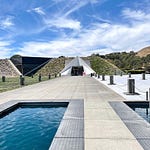Inescapable & Ubiquitous system of cross-domain warfare of trace, track & target. Hunt the target from a distance. SATCOM, 7G SMART DUST, LED lights, Ring Cameras, SMART METERS, Bluetooth, Musical Concerts, Parks, Churches, Stadiums.
The MESH Net-Centric Warfare, formerly called Mosaic.
The Army and Navy are working together on this kill web concept in the Pacific with cross-domain fires. A Navy ship detects an enemy coastal patrol boat close to shore on its radar. It sends the radar images (targeting data) to an Army missile unit on land through a SATCOM [satellite communications] connection. The Army radar can’t see the patrol boat directly because they are behind a hill. The Navy ship takes control of the Army’s fire control system, launches the missiles over the hill, and destroys the enemy patrol boat. Here, we have the Navy controlling and firing the Army’s weapons at a threat to the Navy ship, remotely. The Army and the Air Force are also working on similar cross-domain battle plans.
Case Study Selection DARPA asked the RAND Corporation’s National Security Research Division to conduct a case study to understand the potential challenges facing the transition to Mosaic warfare. The first step was to highlight potential programs to study and compare them, specifically looking at six principal features of a Mosaic warfare system: fractionation (seg regation of warfighting functions onto large numbers of smaller plat forms, as opposed to small numbers of integrated platforms); heteroge neity (the system comprises different parts with unique capabilities); rapid composability (response actions are tailored and made up of differing parts, depending on the threat); system architecture; scalability and multiagent collaboration; and artificial intelligence/machine learning (AI/ML) and autonomy.
Network-centric warfare and all of its associated revolutions in military affairs grow out of and draw their power from the fundamental changes in American society. These changes have been dominated by the co-evolution of economics, information technology, and business processes and organizations, and they are linked by three themes:
The shift in focus from the platform to the network
The shift from viewing actors as independent to viewing them as part of a continuously adapting ecosystem
The importance of making strategic choices to adapt or even survive in such changing ecosystems.











